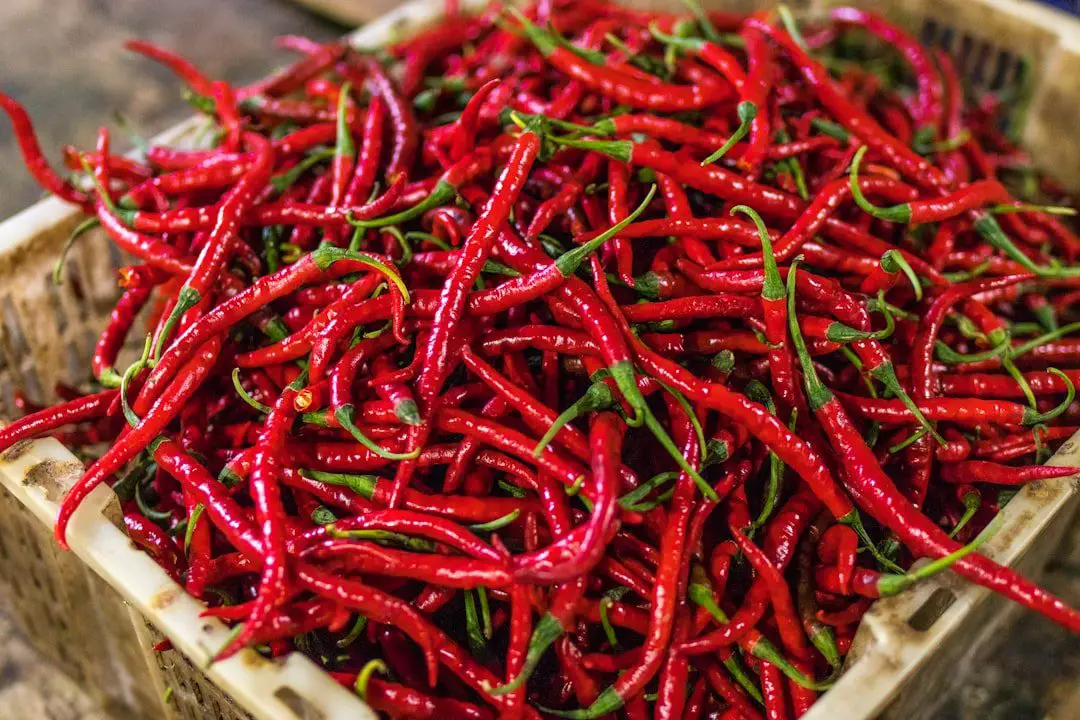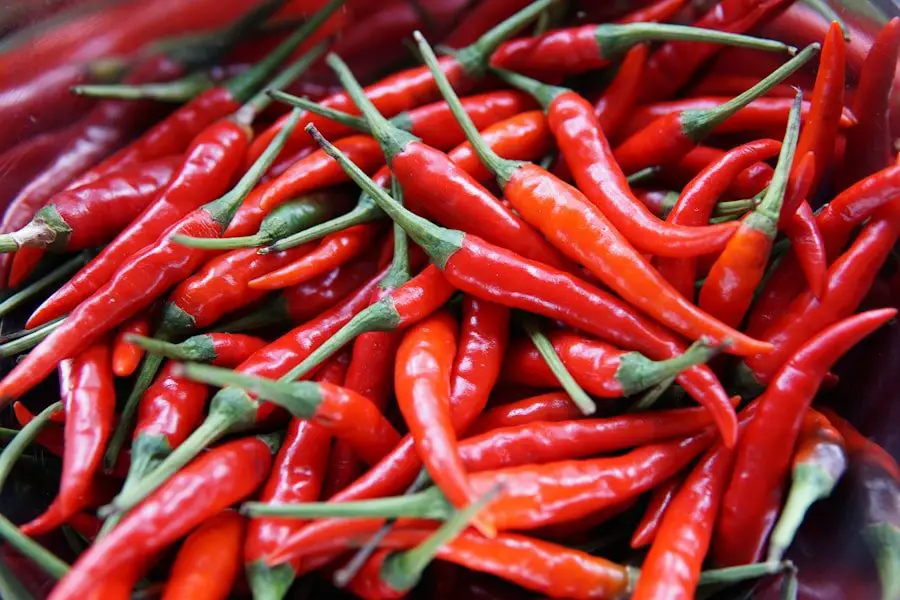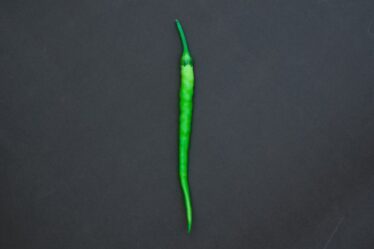
The Chiltepin Pepper, also known as the “mother of all peppers,” is a small, fiery chili pepper that is native to Mexico and the Southwestern United States. It has a long and rich history, dating back thousands of years. The Chiltepin Pepper is believed to have been cultivated by indigenous peoples in the region for its unique flavor and medicinal properties.
In Mexican and Southwestern cuisine, the Chiltepin Pepper holds a special place. It is often referred to as the “queen of peppers” due to its intense heat and complex flavor profile. It is used in a wide variety of dishes, from salsas and hot sauces to stews and marinades. Its versatility and distinct taste make it an essential ingredient in many traditional recipes.
Key Takeaways
- Chiltepin pepper is a versatile spice with a unique flavor profile that is widely used in Mexican and Southwestern cuisine.
- Chiltepin pepper has numerous health benefits and is considered a natural remedy for various ailments.
- Growing and harvesting chiltepin pepper at home is easy and can be done sustainably and eco-friendly.
- Chiltepin pepper is an important part of indigenous cultures and traditions, and has also gained popularity in popular culture.
- Cooking with chiltepin pepper requires some caution, but it can be paired with a variety of ingredients to create delicious dishes.
The Unique Flavor Profile of Chiltepin Pepper
The Chiltepin Pepper is known for its intense heat, which can range from 50,000 to 100,000 Scoville Heat Units (SHU). However, it is not just the heat that sets this pepper apart. It also has a unique flavor profile that combines fruity, smoky, and earthy notes.
When you bite into a Chiltepin Pepper, you will first experience a burst of heat that quickly gives way to a fruity sweetness. This sweetness is followed by a smoky undertone that adds depth and complexity to the flavor. The earthy notes round out the taste, creating a well-balanced and unforgettable culinary experience.
In comparison to other types of peppers, the Chiltepin Pepper stands out for its complexity and depth of flavor. While other peppers may offer heat or sweetness, the Chiltepin Pepper combines both in a harmonious way. Its unique flavor profile makes it a favorite among chefs and food enthusiasts alike.
Health Benefits of Chiltepin Pepper: A Natural Remedy
Beyond its culinary uses, the Chiltepin Pepper also offers a range of health benefits. It is rich in antioxidants, which help to reduce inflammation and protect the body against oxidative stress. These antioxidants can help to prevent chronic diseases such as heart disease and cancer.
The Chiltepin Pepper also contains capsaicin, a compound that has been shown to have anti-inflammatory properties. Capsaicin can help to reduce pain and inflammation in conditions such as arthritis and muscle soreness.
Additionally, the Chiltepin Pepper may aid in weight loss and digestion. The heat from the pepper can increase metabolism and promote fat burning. It can also stimulate the production of digestive enzymes, improving digestion and nutrient absorption.
In traditional medicine, the Chiltepin Pepper has been used for centuries to treat a variety of ailments. It has been used as a natural remedy for coughs, colds, and sore throats. It is also believed to have antimicrobial properties, making it effective against bacteria and fungi.
Culinary Uses of Chiltepin Pepper in Mexican and Southwestern Cuisine
| Culinary Uses of Chiltepin Pepper in Mexican and Southwestern Cuisine |
|---|
| 1. Salsas and Hot Sauces |
| 2. Marinades and Rubs for Meat |
| 3. Seasoning for Stews and Soups |
| 4. Topping for Tacos and Enchiladas |
| 5. Flavoring for Tequila and Mezcal |
| 6. Ingredient in Traditional Dishes like Chiles Rellenos and Mole Sauce |
| 7. Garnish for Salads and Appetizers |
| 8. Infused in Oils and Vinegars |
| 9. Used in Cocktails like Margaritas and Bloody Marys |
| 10. Added to Chocolate for a Spicy Twist |
The Chiltepin Pepper is a staple ingredient in Mexican and Southwestern cuisine. It is used in a wide variety of dishes, adding heat, flavor, and complexity to the recipes.
One popular dish that incorporates Chiltepin Pepper is salsa. The pepper is often crushed or ground into a powder and added to fresh tomatoes, onions, cilantro, and lime juice to create a spicy and flavorful salsa. It can also be used to make hot sauces, adding a fiery kick to tacos, enchiladas, and other Mexican dishes.
In addition to salsas and hot sauces, the Chiltepin Pepper is used in stews and marinades. Its intense heat and complex flavor profile make it an excellent choice for adding depth and spice to these dishes. It can also be used to season grilled meats and vegetables, adding a smoky and fiery flavor.
To incorporate Chiltepin Pepper into your cooking, you can either use the whole pepper or grind it into a powder. If using the whole pepper, be sure to remove the seeds before adding it to your dish, as they can be extremely hot. If using the powder, start with a small amount and adjust to taste, as the heat can vary depending on the batch.
How to Grow and Harvest Chiltepin Pepper at Home
If you want to experience the unique flavor and heat of Chiltepin Pepper firsthand, you can grow it in your own garden or container. Here are some tips for growing and harvesting Chiltepin Pepper at home:
1. Choose the right location: Chiltepin Pepper plants thrive in warm and sunny climates. Choose a location that receives at least six hours of direct sunlight per day.
2. Prepare the soil: Chiltepin Pepper plants prefer well-draining soil that is rich in organic matter. Amend the soil with compost or aged manure before planting.
3. Start from seeds: Chiltepin Pepper seeds can be started indoors six to eight weeks before the last frost date. Plant them in seed trays or small pots filled with seed-starting mix. Keep the soil moist and warm until the seeds germinate.
4. Transplant outdoors: Once the danger of frost has passed and the seedlings have grown to a height of 6-8 inches, they can be transplanted outdoors. Space the plants 12-18 inches apart to allow for proper air circulation.
5. Water and fertilize: Chiltepin Pepper plants require regular watering, especially during dry periods. Water deeply once a week, allowing the soil to dry out slightly between waterings. Fertilize every four to six weeks with a balanced organic fertilizer.
6. Harvesting and preserving: Chiltepin Peppers can be harvested when they turn from green to red. Simply snip the peppers off the plant using a pair of scissors or pruners. To preserve the peppers, you can dry them in a warm, well-ventilated area or use a dehydrator. Once dried, store them in an airtight container.
The Importance of Chiltepin Pepper in Indigenous Cultures and Traditions

The Chiltepin Pepper holds great importance in indigenous cultures and traditions. It has been used for centuries as a staple ingredient in indigenous cuisine and medicine.
In indigenous cuisine, the Chiltepin Pepper is often used to add heat and flavor to traditional dishes. It is considered a sacred ingredient and is used in ceremonies and rituals. The pepper is believed to have spiritual properties and is used to bring balance and harmony to the body and mind.
In traditional medicine, the Chiltepin Pepper is used to treat a variety of ailments. It is believed to have healing properties and is used to alleviate pain, reduce inflammation, and boost the immune system. The pepper is also used as a natural remedy for digestive issues, respiratory problems, and skin conditions.
The Chiltepin Pepper plays a significant role in indigenous cultures and traditions, connecting people to their ancestral roots and preserving their cultural heritage.
Chiltepin Pepper in Popular Culture: From Hot Sauce to Cocktails
The popularity of the Chiltepin Pepper has extended beyond traditional cuisine and into popular culture. It is now commonly used in hot sauces, salsas, and other condiments.
Many hot sauce enthusiasts seek out Chiltepin Pepper-based hot sauces for their intense heat and unique flavor profile. These hot sauces often highlight the fruity sweetness and smoky undertones of the pepper, creating a complex and flavorful condiment.
In addition to hot sauces, the Chiltepin Pepper is also finding its way into cocktails and other beverages. Its intense heat and complex flavor make it an excellent choice for adding a spicy kick to margaritas, bloody marys, and other mixed drinks. It can also be infused into spirits such as tequila or vodka to create unique and flavorful infusions.
The use of Chiltepin Pepper in popular culture reflects its growing popularity and the appreciation for its distinct taste and heat.
Chiltepin Pepper: A Sustainable and Eco-Friendly Spice
One of the benefits of growing and consuming Chiltepin Pepper is its sustainability and eco-friendliness. Unlike many other spices that are grown in monocultures and require large amounts of water and pesticides, Chiltepin Pepper can be grown in small-scale, sustainable systems.
Chiltepin Pepper plants are well-adapted to arid climates and require minimal water once established. They are also resistant to pests and diseases, reducing the need for chemical pesticides. By growing Chiltepin Pepper, you can reduce your environmental impact and support sustainable agriculture practices.
In comparison to other types of spices, such as black pepper or cinnamon, which are often imported from faraway countries, Chiltepin Pepper can be grown locally in the United States. This reduces the carbon footprint associated with transportation and supports local farmers and economies.
By choosing Chiltepin Pepper as a spice in your kitchen, you can make a positive impact on the environment and support sustainable agriculture practices.
Exploring Different Varieties of Chiltepin Pepper
There are several different varieties of Chiltepin Pepper, each with its own unique flavor and heat level. Here is an overview of some of the most popular varieties:
1. Sonoran Chiltepin: This variety is native to the Sonoran Desert region of Mexico and the Southwestern United States. It is known for its intense heat and fruity flavor.
2. Tepin Chiltepin: The Tepin Chiltepin is one of the smallest varieties of Chiltepin Pepper. It is known for its fiery heat and smoky flavor.
3. Chiltepin de Monte: This variety is native to the mountains of Mexico and is known for its complex flavor profile. It has a fruity sweetness with hints of citrus and smoke.
4. Chiltepin Piquin: The Chiltepin Piquin is a larger variety of Chiltepin Pepper. It has a milder heat level compared to other varieties but still packs a punch.
Each variety of Chiltepin Pepper offers a unique taste experience, allowing you to explore different flavors and heat levels in your cooking.
Tips for Cooking with Chiltepin Pepper and Pairing it with Other Ingredients
When cooking with Chiltepin Pepper, it’s important to keep in mind its intense heat level. Here are some tips for cooking with Chiltepin Pepper and pairing it with other ingredients:
1. Start small: If you are new to cooking with Chiltepin Pepper, start with a small amount and gradually increase the heat level to suit your taste. Remember that a little goes a long way, so use it sparingly until you become familiar with its heat level.
2. Balance the flavors: The intense heat of Chiltepin Pepper can be balanced by pairing it with ingredients that have a cooling effect, such as dairy products or citrus fruits. For example, you can add a dollop of sour cream or a squeeze of lime juice to dishes that contain Chiltepin Pepper to mellow out the heat.
3. Experiment with different cuisines: While Chiltepin Pepper is commonly used in Mexican and Southwestern cuisine, don’t be afraid to experiment with other cuisines. Its unique flavor profile can add a spicy kick to dishes from around the world, such as Indian curries, Thai stir-fries, or Caribbean jerk chicken.
4. Use it as a finishing touch: Chiltepin Pepper can be added to dishes at the end of cooking as a finishing touch. This allows the heat and flavor of the pepper to shine through without overpowering the other ingredients.
5. Pair it with complementary flavors: Chiltepin Pepper pairs well with ingredients that have bold flavors and can stand up to its heat. Some examples include garlic, onions, cilantro, cumin, and oregano. These ingredients can enhance the flavor of the pepper and create a well-balanced dish.
By following these tips, you can make the most of Chiltepin Pepper in your cooking and create delicious and flavorful dishes that showcase its unique taste and heat.
If you’re a fan of spicy flavors, you’ll love learning about the chiltepin pepper. This tiny but mighty pepper packs a punch and is a staple in Mexican cuisine. If you’re interested in exploring more unique and flavorful ingredients, check out this article on Flavorful Sips about the delightful brown turkey figs. These sweet and juicy fruits are perfect for adding a touch of elegance to your dishes. Click here to dive into the world of brown turkey figs and discover new ways to incorporate them into your recipes.



